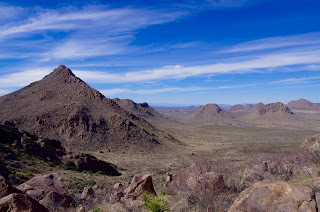Selden Hills, Tonuco Basin Escarpment- Tonuco Uplift
I'd been thinking for a couple of years about visiting a couple of canyons on the southwest corner of the large basin that lies south of Tonuco Peak. The reason why: on Google Earth they strongly resemble some of the slot canyons I've visited near Lake Roberts. Unfortunately, since NMSU has locked the gates that would have allowed closer vehicle access to the entire Tonuco, Selden Hills region, getting to these canyons means a long approach hike over less than scintillating terrain. So, I've continued to put it off. Well, on Monday afternoon, I just bit the bullet, and headed out at a blistering pace from my parking spot on NM 85 across from the Broad Canyon Dam.
I crossed the river and hiked up Flying V Canyon. Staying to the left, I angled my way up arroyos and down ridges to the upper end of Lytten Canyon. I then pushed my way, with one hiking pole and one yucca stalk for leverage, up on the ridge overlooking the basin, with the canyons that were my objective lying directly below me.
Let me say right now that the canyons were a disappointment. They were very small and only mildly slot -like. One was thick with dwarf hackberry trees which would make it bit more attractive come spring, and the alcove pocked sandstone and conglomerate cliffs had a modicum of charm, but that hardly made the two mile approach through monotonous sand and shrubs worth it.
Afterwards I went back through Dancing Man Canyon, where I found a couple more petroglyphs I hadn't spotted last year.


This canyon is deep, peaceful and secluded and made me feel happy to be there despite the wind which had begun its steady, forceful afternoon blow. Rhyolite boulders, and boulders of a conglomerate made of boulders line the sides and lie in the canyon bottom of gray pebbles and sand. It's rough and narrow, even if the grass covered north facing hillside softens the scene and left me wondering why ancient folks would venture up there in the first place. I was reminded as I listened, to cars driving along NM 85, how close I was to the river and that it wouldn't be much of venture for those who lived along the river in ancient times, more like a walk in the backyard.
I walked back through the low growing mesquite and creosote across benches and down into short arroyos. On top of one small bluff above the river and the railroad tracks,hidden by a small berm, I first spotted a perfect triangular prism of igneous rock that gave off the distinct aura of being a prehistoric tool. Then bits and flakes of chert were found in the soft sand. Then, confirming that this was a habitation site, I spotted large pieces of pottery, red and brown, one after another. I slowed down, for the first time that afternoon. I felt connected.
Note: Although the pottery site appears to at least be partially on a small bit of BLM land, the Selden Hills and Tonuco Basin are almost entirely within NMSU's Chihuahuan Desert Research Center land. The property is not posted along every fence line, but it is at intersections and entrances that are along dirt roads on the east side of I-25 and at the north and south entrances along the power line road.This is not public land, although the land was once open to public use. It appears that roads and arroyos along the mesas and in the canyons still receive some use( I saw many recent vehicle tracks),but mostly likely these are people that are coming from private property along the east side of the river. For the present, entering without permission should be considered trespassing.
I walked back through the low growing mesquite and creosote across benches and down into short arroyos. On top of one small bluff above the river and the railroad tracks,hidden by a small berm, I first spotted a perfect triangular prism of igneous rock that gave off the distinct aura of being a prehistoric tool. Then bits and flakes of chert were found in the soft sand. Then, confirming that this was a habitation site, I spotted large pieces of pottery, red and brown, one after another. I slowed down, for the first time that afternoon. I felt connected.
Note: Although the pottery site appears to at least be partially on a small bit of BLM land, the Selden Hills and Tonuco Basin are almost entirely within NMSU's Chihuahuan Desert Research Center land. The property is not posted along every fence line, but it is at intersections and entrances that are along dirt roads on the east side of I-25 and at the north and south entrances along the power line road.This is not public land, although the land was once open to public use. It appears that roads and arroyos along the mesas and in the canyons still receive some use( I saw many recent vehicle tracks),but mostly likely these are people that are coming from private property along the east side of the river. For the present, entering without permission should be considered trespassing.
Labels: hiking




























































